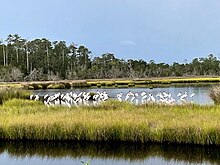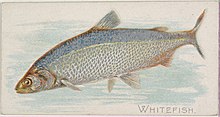User:Sgkimbrell/Estuary
| This is the sandbox page where you will draft your initial Wikipedia contribution.
If you're starting a new article, you can develop it here until it's ready to go live. If you're working on improvements to an existing article, copy only one section at a time of the article to this sandbox to work on, and be sure to use an edit summary linking to the article you copied from. Do not copy over the entire article. You can find additional instructions here. Remember to save your work regularly using the "Publish page" button. (It just means 'save'; it will still be in the sandbox.) You can add bold formatting to your additions to differentiate them from existing content. |
Article Draft[edit]
Effects of Eutrophication on Biogeochemical Cycles[edit]

Nitrogen is often the lead cause of eutrophication in estuaries in temperate zones [1]. During a eutrophication event, biogeochemical feedback decreases the amount of available silica [2]. These feedbacks also increase the supply of nitrogen and phosphorous, creating conditions where harmful algal blooms can persist. Given the now off-balance nitrogen cycle, estuaries can be driven to phosphorous limitation instead of nitrogen limitation. Estuaries can be severely impacted by an unbalanced phosphorus cycle, as phosphorous interacts with nitrogen and silica availability.
With an abundance of nutrients in the ecosystem, plants and algae overgrow and eventually decompose, which produce a significant amount of carbon dioxide [3]. While releasing CO2 into the water and atmosphere, these organisms are also intaking all or nearly all of the available oxygen creating a hypoxic environment and unbalanced oxygen cycle [4]. The excess carbon in the form of CO2 can lead to low pH levels and ocean acidification, which is more harmful for vulnerable coastal regions like estuaries.
Effects of Eutrophication on Estuarine Plants[edit]

Eutrophication has been seen to negatively impact many plant communities in estuarine ecosystems[5]. Salt marshes are a type of ecosystem in some estuaries that have been negatively impacted by eutrophication[5]. Cordgrass vegetation dominates the salt marsh landscape[6]. Excess nutrients allow the plants to grow at greater rates in above ground biomass, however less energy is allocated to the roots since nutrients is abundant[5][7]. This leads to a lower biomass in the vegetation below ground which destabilizes the banks of the marsh causing increased rates of erosion [5]. A similar phenomenon occurs in mangrove swamps, which are another potential ecosystem in estuaries [7][8]. An increase in nitrogen causes an increase in shoot growth and a decrease in root growth[7]. Weaker root systems cause a mangrove tree to be less resilient in seasons of drought, which can lead to the death of the mangrove [7]. This shift in above ground and below ground biomass caused by eutrophication could hindered plant success in these ecosystems[5][7].

Effects of Eutrophication on Estuarine Animals[edit]
Across all biomes, eutrophication often results in plant death but the impacts do not end there. Plant death alters the entire food web structure which can result in the death of animals within the afflicted biome. Estuaries are hotspots for biodiversity, containing a majority of commercial fish catch, making the impacts of eutrophication that much greater within estuaries [9]. Some specific estuarine animals feel the effects of eutrophication more strongly than others. One example is the whitefish species from the European Alps [10]. Eutrophication reduced the oxygen levels in their habitats so greatly that whitefish eggs could not survive, causing local extinctions [10]. However, some animals, such as carnivorous fish, tend to do well in nutrient poor environments and can benefit from eutrophication [11]. This can be seen in populations of bass or pikes [11].
Effects of Eutrophication on Human Activities[edit]

Eutrophication can affect many marine habitats which can lead to economic consequences. The commercial fishing industry relies upon estuaries for approximately 68 percent of their catch by value because of the great biodiversity of this ecosystem[12]. During an algal bloom, fishermen have noticed a significant increase in the quantity of fish[13]. A sudden increase in primary productivity causes spikes in fish populations which leads to more oxygen being utilized[13]. It is the continued deoxygenation of the water that then causes a decline in fish populations. These impacts can begin in estuaries and have a wide impact on the surrounding water bodies. In turn, this can negatively impact fishing industry sales in one area and across the country [14]. Production in 2016 from recreational and commercial fishing contributes billions of dollars to the United States’ gross domestic product (GDP)[12]. A decrease in production within this industry can impact any of the 1.7 million people the fishing industry employs yearly across the United States.
References[edit]
- ^ Howarth, Robert W.; Marino, Roxanne (2006). "Nitrogen as the limiting nutrient for eutrophication in coastal marine ecosystems: Evolving views over three decades". Limnology and Oceanography. 51 (1part2): 364–376. doi:10.4319/lo.2006.51.1_part_2.0364. ISSN 0024-3590.
- ^ Howarth, Robert; Chan, Francis; Conley, Daniel J; Garnier, Josette; Doney, Scott C; Marino, Roxanne; Billen, Gilles (2011). "Coupled biogeochemical cycles: eutrophication and hypoxia in temperate estuaries and coastal marine ecosystems". Frontiers in Ecology and the Environment. 9 (1): 18–26. doi:10.1890/100008. ISSN 1540-9295.
- ^ Morales-Williams, Ana M.; Wanamaker, Alan D.; Williams, Clayton J.; Downing, John A. (2021). "Eutrophication Drives Extreme Seasonal CO2 Flux in Lake Ecosystems". Ecosystems. 24 (2): 434–450. doi:10.1007/s10021-020-00527-2. ISSN 1432-9840.
- ^ Selman, Mindy; Sugg, Zachary; Greenhalgh, Suzie (2008). Eutrophication and Hypoxia in Coastal Areas. ISBN 978-1-56973-681-4.
- ^ a b c d e Deegan, Linda A.; Johnson, David Samuel; Warren, R. Scott; Peterson, Bruce J.; Fleeger, John W.; Fagherazzi, Sergio; Wollheim, Wilfred M. (2012). "Coastal eutrophication as a driver of salt marsh loss". Nature. 490 (7420): 388–392. doi:10.1038/nature11533. ISSN 0028-0836.
- ^ Donnelly, Jeffrey P.; Bertness, Mark D. (2001). "Rapid shoreward encroachment of salt marsh cordgrass in response to accelerated sea-level rise". Proceedings of the National Academy of Sciences. 98 (25): 14218–14223. doi:10.1073/pnas.251209298. ISSN 0027-8424.
- ^ a b c d e Lovelock, Catherine E.; Ball, Marilyn C.; Martin, Katherine C.; C. Feller, Ilka (2009). "Nutrient Enrichment Increases Mortality of Mangroves". PLoS ONE. 4 (5): e5600. doi:10.1371/journal.pone.0005600. ISSN 1932-6203.
{{cite journal}}: CS1 maint: unflagged free DOI (link) - ^ Guest, Michaela A.; Connolly, Rod M. (2005). "Fine-scale movement and assimilation of carbon in saltmarsh and mangrove habitat by resident animals". Aquatic Ecology. 38 (4): 599–609. doi:10.1007/s10452-005-0442-9. ISSN 1386-2588.
- ^ Waltham, Nathan J.; McCann, Jack; Power, Trent; Moore, Matt; Buelow, Christina (2020). "Patterns of fish use in urban estuaries: Engineering maintenance schedules to protect broader seascape habitat". Estuarine, Coastal and Shelf Science. 238: 106729. doi:10.1016/j.ecss.2020.106729. ISSN 0272-7714.
- ^ a b Vonlanthen, P., Bittner, D., Hudson A.G., et al. (2012). Eutrophication causes speciation reversal in whitefish adaptive radiations. Nature. 482, 337-362. DOI: 10.1038/nature0824.
- ^ a b Jeppesen, Erik; Peder Jensen, Jens; Søndergaard, Martin; Lauridsen, Torben; Junge Pedersen, Leif; Jensen, Lars (1997), "Top-down control in freshwater lakes: the role of nutrient state, submerged macrophytes and water depth", Shallow Lakes ’95, Dordrecht: Springer Netherlands, pp. 151–164, ISBN 978-94-010-6382-1, retrieved 2022-04-20
- ^ a b Lellis-Dibble, K.A. (2008). "Estuarine Fish and Shellfish Species in US commercial and Recreational Fisheries: Economic Value as an Incentive to Protect and Restore Estuarine Habitat". National Oceanic and Atmospheric Administration.
- ^ a b Gao, Yang; Lee, Jeong-Yeol (2012-12-30). "Compensatory Responses of Nile Tilapia Oreochromis niloticus under Different Feed-Deprivation Regimes". Fisheries and aquatic sciences. 15 (4): 305–311. doi:10.5657/fas.2012.0305. ISSN 2234-1749.
- ^ Fay, Gavin; DePiper, Geret; Steinback, Scott; Gamble, Robert J.; Link, Jason S. (2019). "Economic and Ecosystem Effects of Fishing on the Northeast US Shelf". Frontiers in Marine Science. 6. doi:10.3389/fmars.2019.00133/full. ISSN 2296-7745.
{{cite journal}}: CS1 maint: unflagged free DOI (link)
